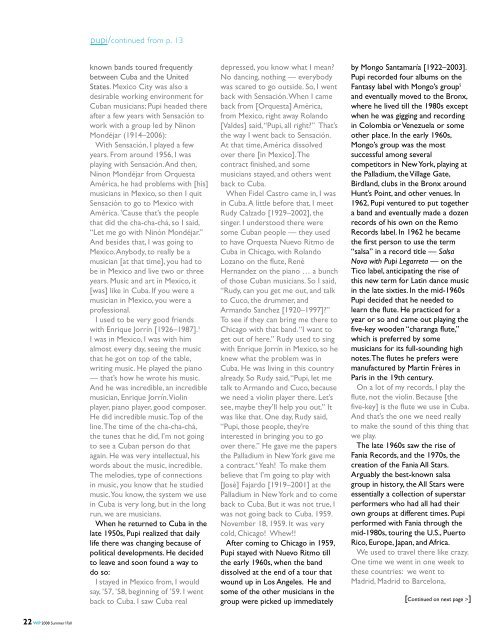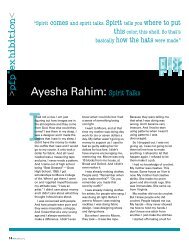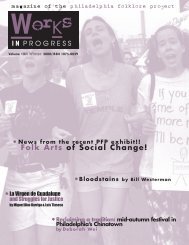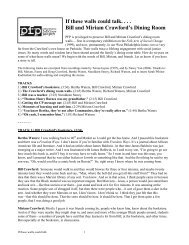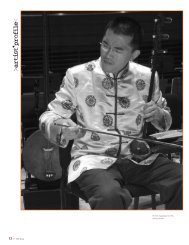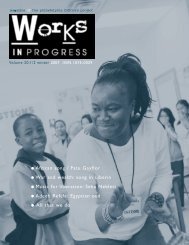View PDF - Philadelphia Folklore Project
View PDF - Philadelphia Folklore Project
View PDF - Philadelphia Folklore Project
You also want an ePaper? Increase the reach of your titles
YUMPU automatically turns print PDFs into web optimized ePapers that Google loves.
pupi/continued from p. 13<br />
known bands toured frequently<br />
between Cuba and the United<br />
States. Mexico City was also a<br />
desirable working environment for<br />
Cuban musicians; Pupi headed there<br />
after a few years with Sensación to<br />
work with a group led by Ninon<br />
Mondéjar (1914–2006):<br />
With Sensación, I played a few<br />
years. From around 1956, I was<br />
playing with Sensación. And then,<br />
Ninon Mondéjar from Orquesta<br />
América, he had problems with [his]<br />
musicians in Mexico, so then I quit<br />
Sensación to go to Mexico with<br />
América. 'Cause that’s the people<br />
that did the cha-cha-chá, so I said,<br />
“Let me go with Ninón Mondéjar.”<br />
And besides that, I was going to<br />
Mexico. Anybody, to really be a<br />
musician [at that time], you had to<br />
be in Mexico and live two or three<br />
years. Music and art in Mexico, it<br />
[was] like in Cuba. If you were a<br />
musician in Mexico, you were a<br />
professional.<br />
I used to be very good friends<br />
with Enrique Jorrín [1926–1987]. 3<br />
I was in Mexico, I was with him<br />
almost every day, seeing the music<br />
that he got on top of the table,<br />
writing music. He played the piano<br />
— that’s how he wrote his music.<br />
And he was incredible, an incredible<br />
musician, Enrique Jorrín. Violin<br />
player, piano player, good composer.<br />
He did incredible music. Top of the<br />
line. The time of the cha-cha-chá,<br />
the tunes that he did, I’m not going<br />
to see a Cuban person do that<br />
again. He was very intellectual, his<br />
words about the music, incredible.<br />
The melodies, type of connections<br />
in music, you know that he studied<br />
music. You know, the system we use<br />
in Cuba is very long, but in the long<br />
run, we are musicians.<br />
When he returned to Cuba in the<br />
late 1950s, Pupi realized that daily<br />
life there was changing because of<br />
political developments. He decided<br />
to leave and soon found a way to<br />
do so:<br />
I stayed in Mexico from, I would<br />
say, ’57, ’58, beginning of ’59. I went<br />
back to Cuba. I saw Cuba real<br />
depressed, you know what I mean<br />
No dancing, nothing — everybody<br />
was scared to go outside. So, I went<br />
back with Sensación. When I came<br />
back from [Orquesta] América,<br />
from Mexico, right away Rolando<br />
[Valdes] said, “Pupi, all right” That’s<br />
the way I went back to Sensación.<br />
At that time, América dissolved<br />
over there [in Mexico]. The<br />
contract finished, and some<br />
musicians stayed, and others went<br />
back to Cuba.<br />
When Fidel Castro came in, I was<br />
in Cuba. A little before that, I meet<br />
Rudy Calzado [1929–2002], the<br />
singer. I understood there were<br />
some Cuban people — they used<br />
to have Orquesta Nuevo Ritmo de<br />
Cuba in Chicago, with Rolando<br />
Lozano on the flute, René<br />
Hernandez on the piano … a bunch<br />
of those Cuban musicians. So I said,<br />
“Rudy, can you get me out, and talk<br />
to Cuco, the drummer, and<br />
Armando Sanchez [1920–1997]”<br />
To see if they can bring me there to<br />
Chicago with that band. “I want to<br />
get out of here.” Rudy used to sing<br />
with Enrique Jorrín in Mexico, so he<br />
knew what the problem was in<br />
Cuba. He was living in this country<br />
already. So Rudy said, “Pupi, let me<br />
talk to Armando and Cuco, because<br />
we need a violin player there. Let’s<br />
see, maybe they’ll help you out.” It<br />
was like that. One day, Rudy said,<br />
“Pupi, those people, they’re<br />
interested in bringing you to go<br />
over there.” He gave me the papers<br />
the Palladium in New York gave me<br />
a contract. 4 Yeah! To make them<br />
believe that I’m going to play with<br />
[José] Fajardo [1919–2001] at the<br />
Palladium in New York and to come<br />
back to Cuba. But it was not true, I<br />
was not going back to Cuba. 1959.<br />
November 18, 1959. It was very<br />
cold, Chicago! Whew!!<br />
After coming to Chicago in 1959,<br />
Pupi stayed with Nuevo Ritmo till<br />
the early 1960s, when the band<br />
dissolved at the end of a tour that<br />
wound up in Los Angeles. He and<br />
some of the other musicians in the<br />
group were picked up immediately<br />
by Mongo Santamaría [1922–2003].<br />
Pupi recorded four albums on the<br />
Fantasy label with Mongo’s group 5<br />
and eventually moved to the Bronx,<br />
where he lived till the 1980s except<br />
when he was gigging and recording<br />
in Colombia or Venezuela or some<br />
other place. In the early 1960s,<br />
Mongo’s group was the most<br />
successful among several<br />
competitors in New York, playing at<br />
the Palladium, the Village Gate,<br />
Birdland, clubs in the Bronx around<br />
Hunt’s Point, and other venues. In<br />
1962, Pupi ventured to put together<br />
a band and eventually made a dozen<br />
records of his own on the Remo<br />
Records label. In 1962 he became<br />
the first person to use the term<br />
“salsa” in a record title — Salsa<br />
Nova with Pupi Legarreta — on the<br />
Tico label, anticipating the rise of<br />
this new term for Latin dance music<br />
in the late sixties. In the mid-1960s<br />
Pupi decided that he needed to<br />
learn the flute. He practiced for a<br />
year or so and came out playing the<br />
five-key wooden “charanga flute,”<br />
which is preferred by some<br />
musicians for its full-sounding high<br />
notes. The flutes he prefers were<br />
manufactured by Martin Frères in<br />
Paris in the 19th century.<br />
On a lot of my records, I play the<br />
flute, not the violin. Because [the<br />
five-key] is the flute we use in Cuba.<br />
And that’s the one we need really<br />
to make the sound of this thing that<br />
we play.<br />
The late 1960s saw the rise of<br />
Fania Records, and the 1970s, the<br />
creation of the Fania All Stars.<br />
Arguably the best-known salsa<br />
group in history, the All Stars were<br />
essentially a collection of superstar<br />
performers who had all had their<br />
own groups at different times. Pupi<br />
performed with Fania through the<br />
mid-1980s, touring the U.S., Puerto<br />
Rico, Europe, Japan, and Africa.<br />
We used to travel there like crazy.<br />
One time we went in one week to<br />
these countries: we went to<br />
Madrid, Madrid to Barcelona,<br />
[Continued on next page >]<br />
22 WIP 2008 Summer / Fall


